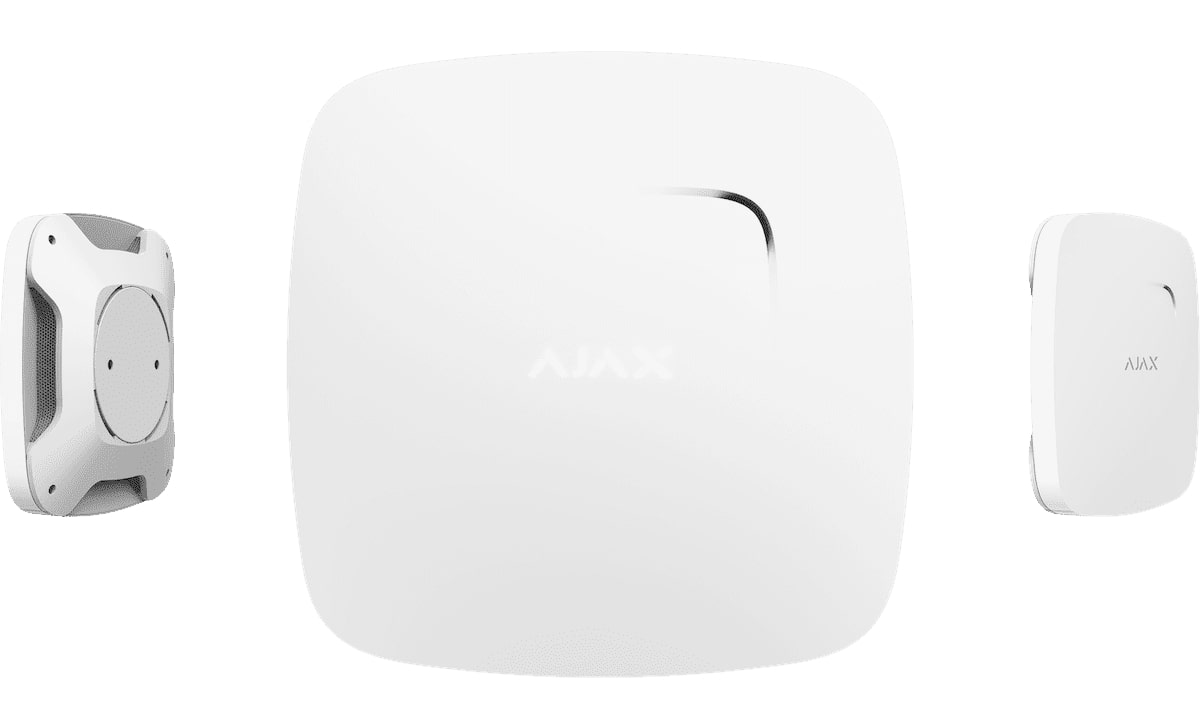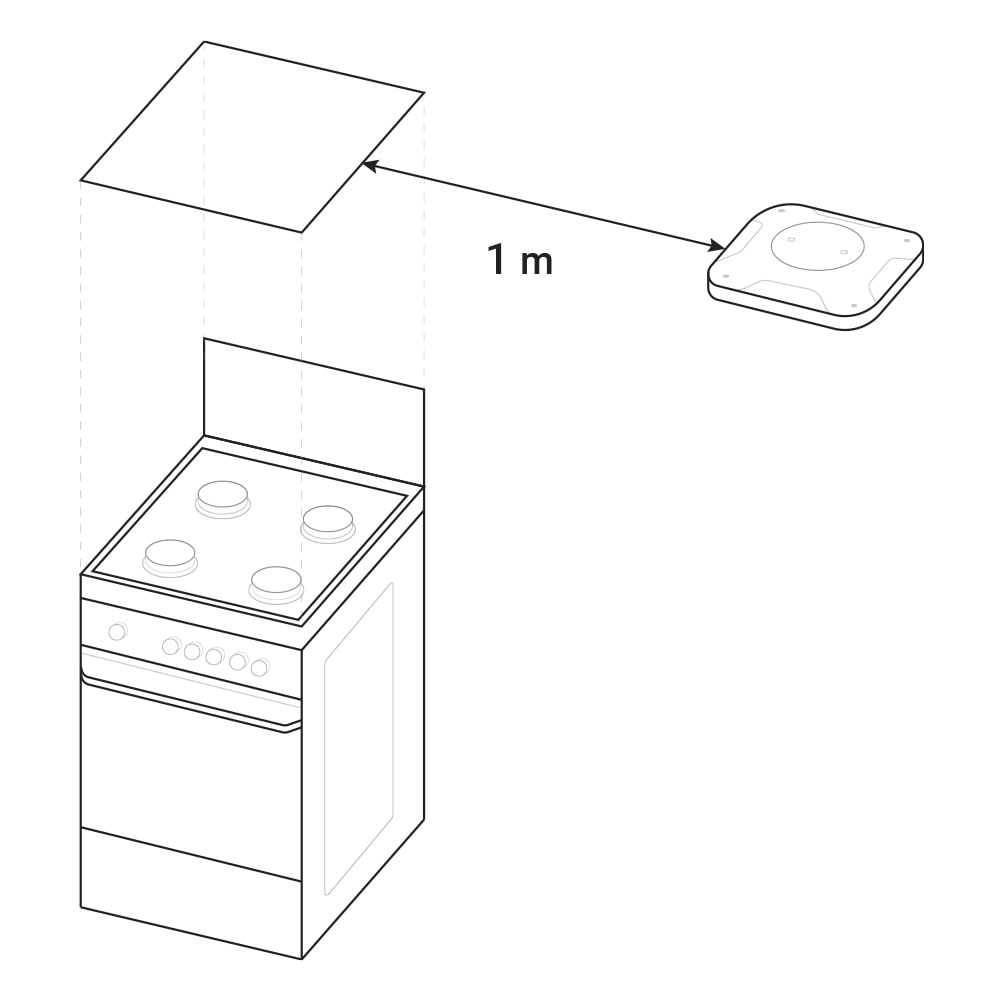The FireProtect Plus installation guidelines are general in nature and are based on EN 50292 standard “Electrical apparatus for the detection of carbon monoxide in domestic premises, caravans, and boats — guide on the selection, installation, use and maintenance”.
Standards and installation requirements for fire detectors may vary by region. Prior to installation, we recommend that you read and understand the regulatory documents applicable in your region or contact a specialist.
What is carbon monoxide
Carbon monoxide or CO — is a colorless and extremely toxic gas without taste and odor that is formed as a result of combustion in the absence of a sufficient amount of oxygen.
Carbon monoxide can be released during a fire as well as by the following sources:
- Household gas appliances, including heating and water heating boilers.
- Grills, wood-burning stoves, fireplaces, and other sources of fire.
- Motor vehicles or fuel generators.
In addition, carbon monoxide can enter the room from the outside, for example, from a busy highway.
The risk of carbon monoxide poisoning is much higher in rooms without fresh air as well as in rooms with faulty ventilation or clogged chimney stacks. Windy weather can lead to backdrafts through ventilation systems and chimneys leading to combustion products accumulating in the room.
Symptoms of carbon monoxide poisoning
Carbon monoxide has neither odor nor color, and humans cannot smell it. Only specialized detectors can detect dangerous CO concentrations in the air.
The concentration of carbon monoxide of less than 0.001% (10 ppm) at home is considered to be normal. A concentration exceeding 0.052% (520 ppm) lasting over a period of two hours causes headaches, dizziness, nausea, and a concentration of 0.1% (1,000 ppm) causes loss of consciousness. When the CO concentration in the air is 0.15% (1,500 ppm), fatal outcome is possible.
How does carbon monoxide disseminate
Carbon monoxide is released during combustion as part of a hot gas mixture and its density is less than that of air. Therefore, CO rises up and accumulates near the ceiling. In order for a detector to detect dangerous concentration of carbon monoxide in a timely manner, it should be installed as high as possible.
Dangerous levels of carbon monoxide are detected only by specialized CO detectors or fire detectors combined with CO sensors. Smoke and heat detectors do not react to carbon monoxide!
Fire detector Ajax FireProtect Plus

FireProtect Plus — is a wireless fire detector fitted with smoke, temperature, and carbon monoxide sensors. The detector monitors the room safety around the clock and reports a fire or a dangerous level of CO instantly. It operates from batteries for up to 4 years and can function independently from a hub notifying of danger using the built-in siren.
The detector tests the smoke chamber and the CO sensor independently reporting on the need for dust removal or malfunctions in a timely manner, and several detectors can trigger an alarm simultaneously.
The life span of the FireProtect Plus detector lasts up to 7 years (up to 10 years for the FireProtect). In the event of a detector failure, you will receive a corresponding notification — it will need to be replaced or submitted for comprehensive diagnostics.
How the FireProtect Plus detector detects dangerous levels of carbon monoxide
FireProtect Plus uses an integrated CO-sensor (NAP-505) to detect dangerous levels of carbon monoxide. The response time of the detector to an alarm depends on the level of carbon monoxide concentration in the air. The higher the concentration, the less time it takes to register an alarm using a detector. This principle of operation is attributed to the features of the human body related to the absorption of carbon monoxide.
The FireProtect Plus CO-sensor is calibrated and tested during the manufacturing stage under laboratory conditions. It is not recommended to check the carbon monoxide detector at home independently, for example, by holding over open sources of fire. An excessively high CO concentration (exceeding 0.1% over a period of 3 minutes) can damage the sensor.
At what level of carbon monoxide the FireProtect Plus detector raises an alarm
FireProtect Plus also responds to dangerous levels of carbon monoxide (CO). The detector generates an alarm if CO concentration reaches:
- 0.003% (30 ppm) within 120 minutes or more;
- 0.005% (50 ppm) within 60 – 89 minutes;
- 0.01% (100 ppm) within 10 – 39 minutes;
- 0.03% (300 ppm) within 3 minutes.
Loss of consciousness is possible at a CO concentration of 0.1% lasting over 2 hours!
The detector stops notifying about the dangerous level of carbon monoxide when the concentration drops to 40 ppm (0.004%) within one minute.
Inside which types of premises should the FireProtect Plus detector be installed
According to the EN 50292 standard, carbon monoxide detectors should be installed in each room containing a potential source of carbon monoxide as well as in each bedroom and premises where residents spend considerable time or may not hear the detector alarm.
By using the Ajax security system, fire protection can be organized with allowance for the potential threat:
- There is a potential source of CO: install a FireProtect Plus detector inside the room. If a potential CO source has a gas outlet, such detectors must be installed in all the rooms through which it passes.
- No source of CO, but there is a possibility of fire: Install FireProtect detectors.
In all rooms where the built-in sirens of fire detectors cannot be heard, install HomeSiren room sirens (or more powerful outdoor StreetSiren or StreetSiren DoubleDeck ones).
In the event of an alarm, the hub notifies all users of the Ajax security system not only by triggering the sirens, but also by push notifications in App, SMS, and phone calls, if this type of notification is enabled. The Interconnected Fire Detectors Alarms function triggers the built-in sirens of all fire detectors if at least one of them detects an alarm.
Where to install FireProtect Plus
When installing the Ajax security system, ensure that the sirens of the fire detectors and sirens of HomeSiren / StreetSiren / StreetSiren DoubleDeck can be clearly heard. It is also desirable that the LED indication of devices be visible.
According to the standard, when used in a studio apartment, a carbon monoxide detector should be fixed as far as possible from electric kitchen appliances but near the bed.
FireProtect Plus can be installed both on a wall and ceiling. With any method of mounting, the detector should be located at a distance of 1 to 3 m from the potential source of carbon monoxide.
For premises without a potential source of CO, the standard also recommends installing carbon monoxide detectors on the walls:
- Inside the bedrooms — near the bed at the level of the face of a sleeping person.
- Along the corridors and stair platforms — at a height of 0.5 to 1.5 meters above the floor.
- In other areas where people spend considerable amount of time — near the workplaces and resting locations at the level of the face of a sitting person.
Note that such placement of the FireProtect Plus detectors will not contribute to effective detection of smoke, only CO concentration and increase in temperature inside the room (less effective in comparison with ceiling mounting).
If the detector is mounted on the ceiling
The detector should be fixed at the highest point where hot air and smoke are accumulated, at a distance of at least 30 cm from the wall.
- If there are beams on the ceiling protruding 30 cm or more from the ceiling level, then the detector should be installed between every two beams.
- If you have a suspended ceiling, then detectors are mounted on its surface. The detectors are also installed on the main ceiling if the distance between the suspended ceiling and the main one exceeds 40 cm. The fire load of the cables (probability of fire) should also be considered — refer to fire standard requirements of your region.
- If you have a stretch ceiling, the detector is fixed on a special structure for mounting fire detectors above the stretch ceiling. If there is no such structure and you do not want to install it, the detector can be mounted on a wall.
If the detector is mounted on a wall
Secure the detector above any door or window, but at least 15 cm from the ceiling.
If there is a partition in the room, the detector should be installed on the same side as the potential source of carbon monoxide.
Do not install the detector:
- Outdoor.
- In places with rapid air circulation (near the ceiling fan, air conditioner, exhaust hood, open doors, and windows).
- At a distance of less than one meter from the cooker and its vertical projection.

- Near metal objects and mirrors that cause attenuation or screening of radio signals.
- In a room with temperature or humidity that is out of range.
- Near open sources of fire.
- In an enclosed space (in a cabinet or behind a partition, curtain).
- In places with blocked access to the detector.
- Above the sink.
- In close proximity to kitchen appliances.
